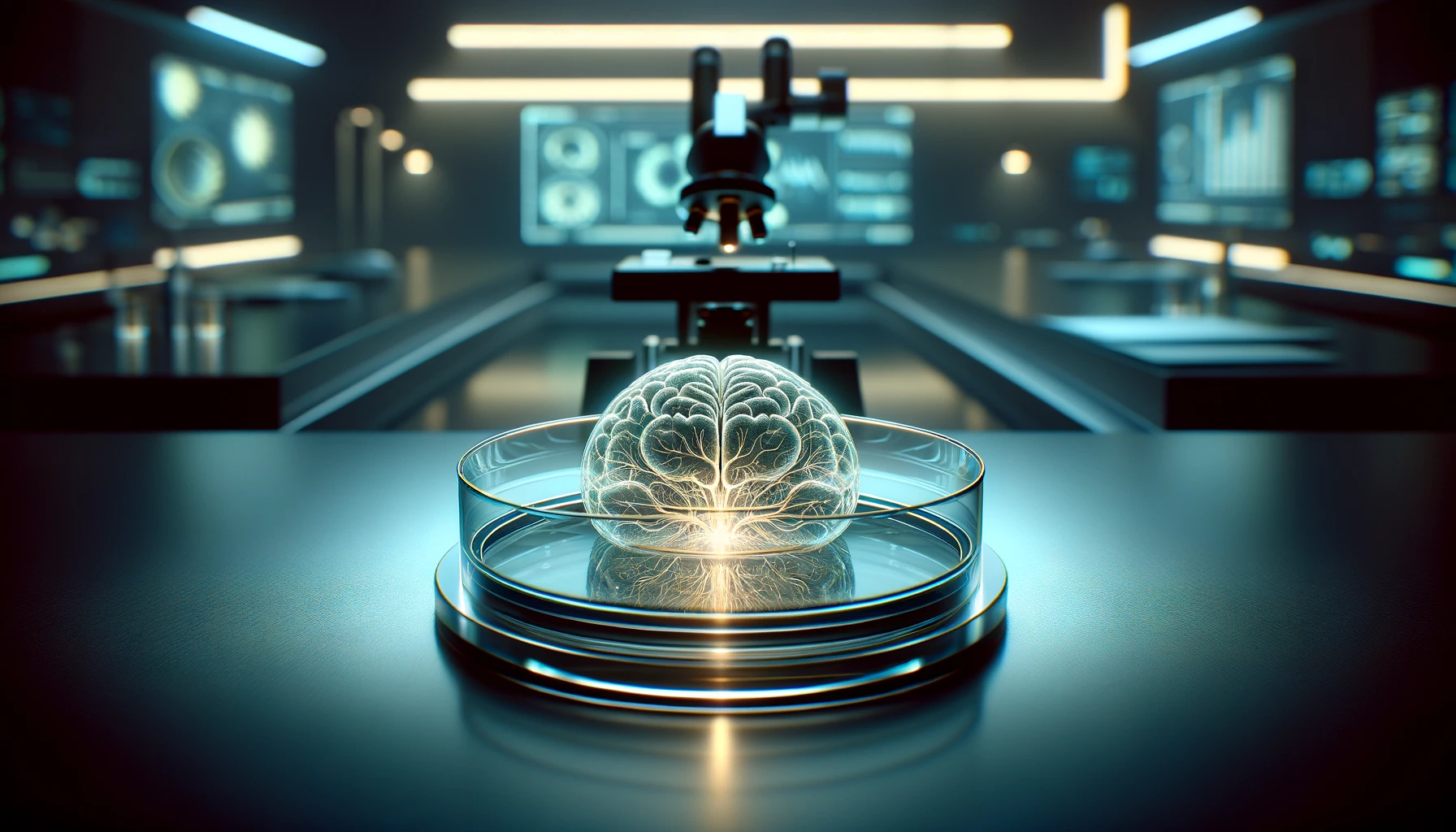A No-Brainer: Organoids for Neuroscience Research
Blog post by Liam Sanio
Brain organoids are three-dimensional models derived from human stem cells, with the purpose of recapitulating the human brain’s structure and function. Often referred to as “mini-brains”, these organoids offer a platform for understanding human brain development, neurodevelopmental disorders, and the effects of various genetic and environmental factors (Yakoub & Sadek, 2019), (Trujillo & Muotri, 2018). Given their more accurate representation of human cerebral complexity, they thus enable the detailed study of synaptic connections, synaptogenesis, and dysfunction, which are crucial for understanding complex neural circuits and neurodevelopmental disorders such as autism.

The significance of brain organoids extends beyond basic research. They are crucial in addressing the limitations of traditional animal models in neuroscience, and offer a more human-relevant model while addressing the ethical concerns associated with animal research. Moreover, brain organoids have promising applications in drug discovery, personalized medicine, and enhancing our understanding and the treatment of neurological diseases (Quadrato et al., 2017), (Gabriel et al., 2020).
It is therefore unsurprising that interest in organoid research is growing rapidly, fueled by both technological advances and the demand for better models in neuroscience. Brain organoids offer a new and exciting opportunity to investigate human brain structure and function in ways that were previously not possible.
The Evolution of Neuroscience Research
Animal models have historically been indispensable in neuroscience research, offering critical insights, but also face limitations due to species-specific differences and ethical concerns. Brain organoids, on the other hand, replicate many key features of early human brain development at molecular, cellular, structural, and functional levels, including aspects that are unique to humans. The introduction of immortalized or primary cell lines, and later induced pluripotent stem cells, represented substantial progress, yet these methods often failed to fully mimic the in vivo microenvironment of the developing or pathological human brain. (Panoutsopoulos, 2020). (Qian, Song, & Ming, 2019).
The Structure and Development of Brain Organoids
The development of brain organoids takes things a step further. These 3D structures are created from human pluripotent stem cells such as induced pluripotent stem cells (iPSCs) or embryonic stem cells. This process involves the self-assembly of stem cells and progenitor cells into multicellular structures that closely resemble the human brain’s cell anatomical structure, architecture, and cell-cell interactions, overcoming the translational challenges posed by traditional animal and 2D cell models, making them particularly significant for studying human brain development and disorders. (Zubareva et al., 2021), (Lancaster et al., 2013).
As they develop, these organoids display various discrete but interdependent brain regions including a cerebral cortex. They have also been shown to generate a broad diversity of cells related to endogenous classes, including those from the cerebral cortex and retina. These organoids can develop over extended periods, allowing for the establishment of mature features like the formation of dendritic spines and spontaneously active neuronal networks. Moreover, the functionality of neurons within organoids has been confirmed through studies showing network-like activities and electrophysiological properties similar to the human brain (Trujillo & Muotri, 2018), (Quadrato et al., 2017).
Research Insights: The Pasca Lab at Stanford
The Pasca Lab at Stanford University is at the forefront of innovative research in brain organoids, primarily focusing on the genetic manipulation of progenitor cells. This manipulation intentionally introduces key components of neurological diseases into the organoids, providing a dynamic model for studying these diseases and exploring potential treatments. The lab’s research also includes implanting these organoids into host animals, where they have demonstrated the ability to form meaningful connections with existing brain structures. (Revah et al., 2022) This breakthrough offers a promising new avenue for future therapies aimed at repairing damaged or missing parts of the brain, marking a major advancement in neurological research and treatment possibilities.
Diagnostic Biochips’ Probes for Organoid Research
Organoids inherently exhibit cellular heterogeneity, mimicking the diverse cell types found in real organs. Diagnostic Biochips’s silicon probes provide a powerful tool for exploring this cellular diversity at a single-cell level. By capturing individual cell responses and variations in real time, researchers can gain insights into the heterogeneity of cell populations within organoids, aiding in the identification of cell types or subpopulations crucial for specific physiological functions.
One of the key advantages of using Diagnostic Biochips’s probes in organoid applications is the ability to achieve real-time monitoring of dynamic processes. DBC’s probes are designed to collect electrical activity data from up to 128 channels simultaneously. This real-time data acquisition facilitates a comprehensive understanding of the organoid’s responses to external stimuli and its internal communication network. Such comprehensive data sets enable a more nuanced understanding of organoid functionality, paving the way for breakthroughs in deciphering complex biological processes.
To learn more about Diagnostic Biochips’ research tools for electrophysiology research, CLICK HERE.

Brain Organoids and Ethical Considerations
The use of brain organoids in research brings forth unique ethical considerations, particularly when compared to traditional animal models and direct human brain studies. Animal models raise concerns related to animal welfare and the translatability of findings to human biology. Direct studies on human brains, though ideal, are severely limited due to ethical and practical constraints. Brain organoids offer a middle ground, bypassing these issues associated with animal research while avoiding the direct manipulation of human brains.
However, this emerging technology is not devoid of criticism. The primary concerns revolve around the moral status of these organoids, especially as they gain complexity and exhibit neural activity resembling human brains. Issues of consent from donors of the original cells, potential consciousness or sentience in advanced organoids, and the implications of creating human-animal chimeras when organoids are transplanted into animals are at the forefront of ongoing discussions. These debates necessitate careful consideration and development of new guidelines tailored to the unique nature of brain organoid research (Ide, Matsuoka, & Fujita, 2021), (Barnhart & Dierickx, 2023).
Future Prospects
Brain organoids are a significant development in neuroscience research, providing a new means for studying the human brain and its disorders. They are part of a wider range of new tools, techniques, and models, each contributing to our understanding and potential treatment of neurological conditions. The future of brain organoid research, supported by a diverse array of innovative approaches, promises not only a deeper understanding of the human brain but also the development of novel therapeutic strategies. This marks a new, dynamic era in neuroscience, where the convergence of various scientific achievements paves the way for groundbreaking discovery and ultimately, novel treatments.
About the Author
About the Author

Liam Sanio has a Bachelor of Medical Sciences degree specializing in Microbiology and Immunology at the University of Western Ontario and is currently a Senior Project Manager with Scientist.com’s Marketing Services team. His role involves planning and coordinating projects that connect scientific research with broader audiences, leveraging his background in the life sciences to support effective marketing strategies.
References
- Barnhart, A. J., & Dierickx, K. (2023). A tale of two chimeras: Applying the six principles to human brain organoid xenotransplantation. Cambridge Quarterly of Healthcare Ethics, 32(4), 555–571. https://doi.org/10.1017/s0963180123000051
- Gabriel, E., Ramani, A., Altinisik, N., & Gopalakrishnan, J. (2020). Human brain organoids to decode mechanisms of microcephaly. Frontiers in Cellular Neuroscience, 14. https://doi.org/10.3389/fncel.2020.00115
- Ide, K., Matsuoka, N., & Fujita, M. (2021). Ethical aspects of brain organoid research in news reports: An exploratory descriptive analysis. Medicina, 57(6), 532. https://doi.org/10.3390/medicina57060532
- Lancaster, M. A., Renner, M., Martin, C.-A., Wenzel, D., Bicknell, L. S., Hurles, M. E., Homfray, T., Penninger, J. M., Jackson, A. P., & Knoblich, J. A. (2013). Cerebral organoids model human brain development and microcephaly. Nature, 501(7467), 373–379. https://doi.org/10.1038/nature12517
- Panoutsopoulos, A. A. (2020). Organoids, Assembloids, and novel biotechnology: Steps Forward in developmental and disease-related neuroscience. The Neuroscientist, 27(5), 463–472. https://doi.org/10.1177/1073858420960112
- Qian, X., Song, H., & Ming, G. (2019). Brain organoids: Advances, applications and challenges. Development, 146(8). https://doi.org/10.1242/dev.166074
- Quadrato, G., Nguyen, T., Macosko, E. Z., Sherwood, J. L., Min Yang, S., Berger, D. R., Maria, N., Scholvin, J., Goldman, M., Kinney, J. P., Boyden, E. S., Lichtman, J. W., Williams, Z. M., McCarroll, S. A., & Arlotta, P. (2017). Cell diversity and network dynamics in photosensitive human brain organoids. Nature, 545(7652), 48–53. https://doi.org/10.1038/nature22047
- Revah, O., Gore, F., Kelley, K. W., Andersen, J., Sakai, N., Chen, X., Li, M.-Y., Birey, F., Yang, X., Saw, N. L., Baker, S. W., Amin, N. D., Kulkarni, S., Mudipalli, R., Cui, B., Nishino, S., Grant, G. A., Knowles, J. K., Shamloo, M., … Pașca, S. P. (2022). Maturation and circuit integration of transplanted human cortical organoids. Nature, 610(7931), 319–326. https://doi.org/10.1038/s41586-022-05277-w
- Trujillo, C. A., & Muotri, A. R. (2018). Brain organoids and the study of Neurodevelopment. Trends in Molecular Medicine, 24(12), 982–990. https://doi.org/10.1016/j.molmed.2018.09.005
- Yakoub, A. M., & Sadek, M. (2019). Analysis of synapses in cerebral organoids. Cell Transplantation, 28(9–10), 1173–1182. https://doi.org/10.1177/0963689718822811
- Zubareva, E. V., Nadezhdin, S. V., Nadezhdina, N. A., Belyaeva, V. S., Burda, Y. E., Avtina, T. V., Gudyrev, O. S., Kolesnik, I. M., Kulikova, S. Yu., & Mishenin, M. O. (2021). 3D organotypic cell structures for drug development and microorganism-host Interaction Research. Research Results in Pharmacology, 7(1), 47–64. https://doi.org/10.3897/rrpharmacology.7.62118